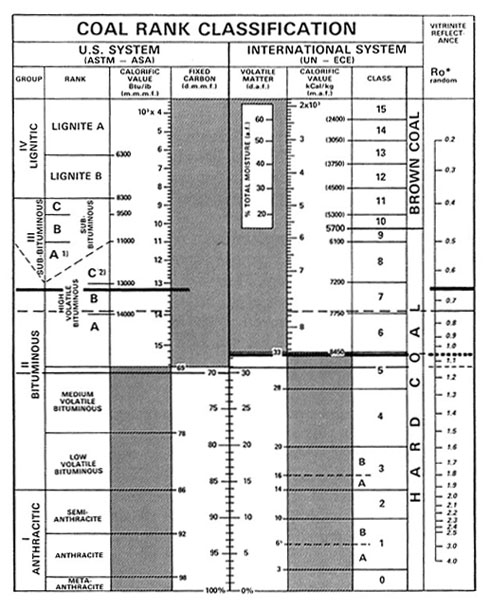-
How do I determine coal rank by the Vitrinite Reflectance method?
Date posted:
-
-
Post Author
dev@edge.studio
1. Background
[GLOSS]Coal[/GLOSS] is introduced as an industrial fuel in Combustion File (CF) 62 and described in detail in CF177.
Coal characterisation is introduced in CF48 in relation to the general question of “What is pulverised fuel characterisation?”, in which the possibilities of [GLOSS]Maceral Analysis[/GLOSS] are introduced. Coal [GLOSS]Macerals[/GLOSS] are described and discussed in CF179.
The present CF explains the determination of coal rank using the Vitrinite Reflectance Method.
Full details of coal sampling requirements for determining vitrinite reflectance particularly sample preparation, are as for the analysis of coals for macerals and are outlined below. Further details can be found in CF181.
2. Sampling of the coal
Coal samples may be taken in a variety of ways:
· From core samples, taken from coal seams.
· From mined coal.
· From coal during or after its preparation for processes such as [GLOSS]coke[/GLOSS] and [GLOSS]briquette[/GLOSS] production.
Regardless of the source of the coal sample, a polished section must be prepared.
In general, the sample must be dried, finely ground (not to PF fineness) and mixed with a synthetic resin (such as [GLOSS]Araldite®[/GLOSS]).
Enough synthetic resin should be added to give sufficient strength to the sample for polishing.
If large sized coal particle fractions are used large errors in the subsequent analysis will result. An approximate idea of the number of samples required for a representative analysis is given in Table 1 below.
|
Maximum grain size |
Polished surface Area |
Minimum number of samples |
|
5 |
55×55 |
5 |
|
3 |
35×35 |
3 |
|
1 |
25×25 |
1 |
Table 1: Number of specimens required to obtain
a representative quantitative analysis
Once a sample is prepared, it is then subject to several stages of polishing on high speed polishing machines using chromium oxide or high-grade alumina.
After the sample has been prepared it is place in an immersion oil and goes under the Berek Photometer for reflectance determination, see Section 3.
3.Rank Determination by Vitrinite Reflectance
The rank of a coal is characteristic of the stage reached during the coal transformation process.
Because the technological properties of coal, in particular its coking and combustion behaviour, depend significantly on coal rank, and only to a secondary degree on maceral (or [GLOSS]microlithotype[/GLOSS]) content, the exact determination of coal rank has always been an important subject in coal research.
It has been demonstrated that the reflectance of vitrinite increases progressively with coal rank, as measured with the Berek photometer for reflectance determination (see Section 3).
Figure 1 shows a range of coal rank indicators including vitrinite reflectance (mean random reflectance is used as opposed to maximum reflectance).

Figure 1: Coal rank indicator parameters including mean random reflectance of the vitrinite (Ro)
4. Reflectance measurement
With the Berek photometer, the traditional method for determining vitrinite reflectance, the intensity of the beam of light reflected from the polished surface of the coal sample is compared with a standard of known reflectance.
The ocular is normally immersed in the same immersion oil as the sample under analysis or if oil is not available, in air.
The reflectance of a coal can be calculated using Equation 1.
Ro = (sinsVi/sinss)Rs (1)
Where:
Ro = reflectance of the vitrinite
svi = value recorded for vitrinite on the photometer
ss = value recorded for the standard on the photometer
Rs = reflectance of the standard
Normally non-absorbing isotropic substances are used as standards, the reflectance of which can be calculated from the respective refractive indices according to the Fresnel-Beer equation, Equation 2 given below:
Rs = [(ns–ni)2 + ns2Ks2]/[(ns+ni)2 + ns2Ks2] (2)
Where:
Rs = reflectance of the standard
ns = refractive index of the standard
ni = refractive index of the immersion oil or air
Ks = absorption index of the standard
Vitrinite reflectance has been shown to be the most reliable method for determining the rank of a coal.
A further and final point for information is that the aforementioned technique is very effective in determining whether a particular coal is a “blend”.
Sources
[1] E. Stach et al., Stach’s Textbook of coal petrology, ISBN 3443390684, Borntraeger, Berlin (1975).
[2] D. W. Van Krevelen, Coal – Typology, Chemistry, Physics and Constitution. ISBN 044440600, Elsevier, Amsterdam, 1981.
[3] J. F. Unsworth, D. J. Barratt and P. T. Roberts. Coal Quality and Combustion Performance – An International Perspective. ISBN 0444887032, Elsiver – Amsterdam (1991).
[4] L. Thomas, Handbook of Practical Coal Geology, ISBN 0 471 93557 3, John Wiley and Sons, Chichester (1992).
